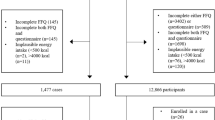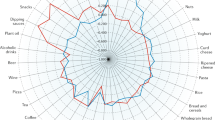Abstract
Background/Objectives:
Cancer is the primary cause of disease-related death in Korea. The purposes of this study were to confirm the major dietary patterns and to evaluate whether there were associations between these identified dietary patterns and the risk of cancer based on data from the Cancer Screening Examination Cohort (CSEC) 2004–2008 of the National Cancer Center (NCC) of Korea.
Subjects/Methods:
This study included 8 024 subjects who completed a written survey on demographics and lifestyles, as well as a 3-day dietary record. Dietary patterns were identified by factor analysis using the principal component analysis method. The associations between the identified dietary patterns and cancer risk were examined using Cox proportional hazards regression models.
Results:
During a median follow-up period of 9.0 years, 425 cancer cases were newly diagnosed. We identified 4 major dietary patterns (‘rice and kimchi’, ‘vegetables and fish’, ‘fruits and dairy’, and ‘meats and sweets’). There was a negative relation between ‘rice and kimchi’ pattern and the risk of non-gastrointestinal cancers only (highest vs. lowest tertile; multivariate-adjusted hazard ratio=0.60, 95% confidence interval=0.41, 0.88). The ‘fruits and dairy’ pattern tended to decrease the risk of cancer, and the preventive effect was noted only for gastrointestinal cancer risk. However, there was no association after adjusting for covariates.
Conclusions:
The traditional dietary pattern with high consumption of rice, kimchi, soybean paste and vegetables may decrease the cancer risk among Koreans, and strategies based on the dietary pattern may effectively reduce the cancer risk.
This is a preview of subscription content, access via your institution
Access options
Subscribe to this journal
Receive 12 print issues and online access
$259.00 per year
only $21.58 per issue
Buy this article
- Purchase on Springer Link
- Instant access to full article PDF
Prices may be subject to local taxes which are calculated during checkout
Similar content being viewed by others
References
Jung KW, Won YJ, Kong HJ, Oh CM, Lee DH, Lee KH . Cancer statistics in Korea: incidence, mortality, survival, and prevalence in 2012. Cancer Res Treat 2015; 47: 127–141.
Willett WC . Diet and cancer. Oncologist 2000; 5: 393–404.
World Cancer Research Fund and American Institute for Cancer Research Food, Nutrition, Physical Activity, and the Prevention of Cancer: a Global Perspective. AICR: Washington, DC, USA, 2007.
Key TJ, Schatzkin A, Willett WC, Allen NE, Spencer EA, Travis RC . Diet, nutrition and the prevention of cancer. Public Health Nutr 2004; 7: 187–200.
Divisi D, Di Tommaso S, Salvemini S, Garramone M, Crisci R . Diet and cancer. Acta Biomed 2006; 77: 118–123.
Percik R, Stumvoll M . Obesity and cancer. Exp Clin Endocrinol Diabetes 2009; 117: 563–566.
Doll R, Peto R . The causes of cancer: quantitative estimates of avoidable risks of cancer in the United States today. J Natl Cancer Inst 1981; 66: 1191–1308.
Wie GA, Cho YA, Kang HH, Ryu KA, Yoo MK, Kim YA et al. Red meat consumption is associated with an increased overall cancer risk: a prospective cohort study in Korea. Br J Nutr 2014; 112: 238–247.
Woo HD, Park S, Oh K, Kim HJ, Shin HR, Moon HK et al. Diet and cancer risk in the Korean population: a meta- analysis. Asian Pac J Cancer Prev 2014; 15: 8509–8519.
Hu FB . Dietary pattern analysis: a new direction in nutritional epidemiology. Curr Opin Lipidol 2002; 13: 3–9.
De Stefani E, Deneo-Pellegrini H, Boffetta P, Ronco AL, Aune D, Acosta G et al. Dietary patterns and risk of cancer: a factor analysis in Uruguay. Int J Cancer 2009; 124: 1391–1397.
Kant AK . Dietary patterns and health outcomes. J Am Diet Assoc 2004; 104: 615–635.
Campbell PT, Sloan M, Kreiger N . Dietary patterns and risk of incident gastric adenocarcinoma. Am J Epidemiol 2008; 167: 295–304.
Kim MK, Sasaki S, Sasazuki S, Tsugane S . Prospective study of three major dietary patterns and risk of gastric cancer in Japan. Int J Cancer 2004; 110: 435–442.
Kim MK, Sasaki S, Otani T, Tsugane S . Dietary patterns and subsequent colorectal cancer risk by subsite: a prospective cohort study. Int J Cancer 2005; 115: 790–798.
Mizoue T, Yamaji T, Tabata S, Yamaguchi K, Shimizu E, Mineshita M et al. Dietary patterns and colorectal adenomas in Japanese men: the Self-Defense Forces Health Study. Am J Epidemiol 2005; 161: 338–345.
Nkondjock A, Krewski D, Johnson KC, Ghadirian P . Dietary patterns and risk of pancreatic cancer. Int J Cancer 2005; 114: 817–823.
Markaki I, Linos D, Linos A . The influence of dietary patterns on the development of thyroid cancer. Eur J Cancer 2003; 39: 1912–1919.
Kim S, Moon S, Popkin BM . The nutrition transition in South Korea. Am J Clin Nutr 2000; 71: 44–53.
Lee MJ, Popkin BM, Kim S . The unique aspects of the nutrition transition in South Korea: the retention of healthful elements in their traditional diet. Public Health Nutr 2002; 5: 197–203.
Lee SK, Sobal J . Socio-economic, dietary, activity, nutrition and body weight transitions in South Korea. Public Health Nutr 2003; 6: 665–674.
Zhang J, Dhakal IB, Zhao Z, Li L . Trends in mortality from cancers of the breast, colon, prostate, esophagus, and stomach in East Asia: role of nutrition transition. Eur J Cancer Prev 2012; 21: 480–489.
Kang M, Joung H, Lim JH, Lee YS, Song Y . Secular Trend in dietary Patterns in a Korean Adult Population, Using the 1998, 2001, and 2005 Korean National Health and Nutrition Examination Survey. Korean J Nutr 2011; 44: 152–161.
Lim H, Kim SY, Wang Y, Lee SJ, Oh K, Sohn CY et al. Preservation of a traditional Korean dietary pattern and emergence of a fruit and dairy dietary pattern among adults in South Korea: secular transitions in dietary patterns of a prospective study from 1998 to 2010. Nutr Res 2014; 34: 760–770.
Kwon JH, Shim JE, Park MK, Paik HY . Evaluation of fruits and vegetables intake for prevention of chronic disease in Korean adults aged 30 years and over: using the third Korea National Health and Nutrition Examination Survey (KNHANES III), 2005. Korean J Nutr 2009; 42: 146–157.
Suh SW, Koo BK, Jeon SH, Lee HS . Anaysis of Dietary risk Factors of the Colorectal Cancer Patients in Daegu.Gyungbuk Area, Korea. Korean J Nutr 2005; 38: 125–143.
Oh SY, Lee JH, Kim HJ . Analyses on the Associations of Dietary Patients with Colon Cancer Risk. Korean J Nutr 2004; 37: 550–556.
Kim J, Kim DH, Lee BH, Kang SH, Lee HJ, Lim SY et al. Folate intake and the risk of colorectal cancer in a Korean population. Eur J Clin Nutr 2009; 63: 1057–1064.
Cho YA, Kim J, Shin A, Park KS, Ro J . Dietary patterns and breast cancer risk in Korean women. Nutr Cancer 2010; 62: 1161–1169.
World Health Organization International Classification of Diseases and Related Health Problems 10th revision ed. WHO: Geneva, Switzerland, 1994.
Dietary Reference intake for Korean The Korean Nutrition Society. Hanareum Press: Seoul: Republic of Korea, 2010, pp 524–547.
Kim J, Jo I . Grains, vegetables, and fish dietary pattern is inversely associated with the risk of metabolic syndrome in South korean adults. J Am Diet Assoc 2011; 111: 1141–1149.
Shin S, Joung H . A dairy and fruit dietary pattern is associated with a reduced likelihood of osteoporosis in Korean postmenopausal women. Br J Nutr 2013; 110: 1926–1933.
Kim J, Jo I, Joung H . A rice-based traditional dietary pattern is associated with obesity in Korean adults. J Acad Nutr Diet 2012; 112: 246–253.
Hong S, Song Y, Lee KH, Lee HS, Lee M, Jee SH et al. A fruit and dairy dietary pattern is associated with a reduced risk of metabolic syndrome. Metabolism 2012; 61: 883–890.
Shin S, Song J, Joung H . A fruit, milk and whole grain dietary pattern is positively associated with bone mineral density in Korean healthy adults. Eur J Clin Nutr 2015; 69: 442–448.
Kumagai Y, Chou WT, Tomata Y, Sugawara Y, Kakizaki M, Nishino Y et al. Dietary patterns and colorectal cancer risk in Japan: the Ohsaki Cohort Study. Cancer Causes Control 2014; 25: 727–736.
Chen H, Ward MH, Graubard BI, Heineman EF, Markin RM, Potischman NA et al. Dietary patterns and adenocarcinoma of the esophagus and distal stomach. Am J Clin Nutr 2002; 75: 137–144.
World Health Organization. WHO Techical Reports Series 916 Diet, Nutrition and the Prevention of Chronic Disease Report of a Joint WHO/FAO Expert Consultation. WHO: Geneva, Switzerland, 2003.
Williams MT, Hord NG . The role of dietary factors in cancer prevention: beyond fruits and vegetables. Nutr Clin Pract 2005; 20: 451–459.
Park SY, Murphy SP, Wilkens LR, Nomura AM, Henderson BE, Kolonel LN . Calcium and vitamin D intake and risk of colorectal cancer: the Multiethnic Cohort Study. Am J Epidemiol 2007; 165: 784–793.
Park SY, Murphy SP, Wilkens LR, Stram DO, Henderson BE, Kolonel LN . Calcium, vitamin D, and dairy product intake and prostate cancer risk: the Multiethnic Cohort Study. Am J Epidemiol 2007; 166: 1259–1269.
Larsson SC, Giovannucci E, Wolk A . Folate intake, MTHFR polymorphisms, and risk of esophageal, gastric, and pancreatic cancer: a meta-analysis. Gastroenterology 2006; 131: 1271–1283.
Kesse-Guyot E, Bertrais S, Peneau S, Estaquio C, Dauchet L, Vergnaud AC et al. Dietary patterns and their sociodemographic and behavioural correlates in French middle-aged adults from the SU.VI.MAX cohort. Eur J Clin Nutr 2009; 63: 521–528.
Engeset D, Alsaker E, Ciampi A, Lund E . Dietary patterns and lifestyle factors in the Norwegian EPIC cohort: the Norwegian Women and Cancer (NOWAC) study. Eur J Clin Nutr 2005; 59: 675–684.
Perrin AE, Dallongeville J, Ducimetiere P, Ruidavets JB, Schlienger JL, Arveiler D et al. Interactions between traditional regional determinants and socio-economic status on dietary patterns in a sample of French men. Br J Nutr 2005; 93: 109–114.
Butler LM, Wu AH, Wang R, Koh WP, Yuan JM, Yu MC . A vegetable-fruit-soy dietary pattern protects against breast cancer among postmenopausal Singapore Chinese women. Am J Clin Nutr 2010; 91: 1013–1019.
Jun S, Ha K, Chung S, Joung H . Meat and milk intake in the rice-based Korean diet: impact on cancer and metabolic syndrome. Proc Nutr Soc 2016; 15: 1–11.
Hearty AP, Gibney MJ . Comparison of cluster and principal component analysis techniques to derive dietary patterns in Irish adults. Br J Nutr 2009; 101: 598–608.
Martinez ME, Marshall JR, Sechrest L . Invited commentary: Factor analysis and the search for objectivity. Am J Epidemiol 1998; 148: 17–19.
Acknowledgements
This work was supported by the National Research Foundation of Korea (NRF) grant funded by the Korea government (MSIP) (NRF-2014R1A2A2A01003138).
Author information
Authors and Affiliations
Corresponding authors
Ethics declarations
Competing interests
The authors declare no conflict of interest.
Rights and permissions
About this article
Cite this article
Wie, GA., Cho, YA., Kang, Hh. et al. Identification of major dietary patterns in Korean adults and their association with cancer risk in the Cancer Screening Examination Cohort. Eur J Clin Nutr 71, 1223–1229 (2017). https://doi.org/10.1038/ejcn.2017.6
Received:
Revised:
Accepted:
Published:
Issue Date:
DOI: https://doi.org/10.1038/ejcn.2017.6
This article is cited by
-
Nutrition-wide association study of microbiome diversity and composition in colorectal cancer patients
BMC Cancer (2022)
-
Association between dietary intake networks identified through a Gaussian graphical model and the risk of cancer: a prospective cohort study
European Journal of Nutrition (2022)
-
Dietary patterns and gastric cancer risk in a Korean population: a case–control study
European Journal of Nutrition (2021)
-
Dietary pattern, dietary total antioxidant capacity, and dyslipidemia in Korean adults
Nutrition Journal (2019)



